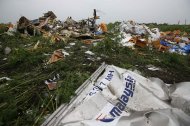Malaysia Airlines flight MH17 broke up in the air as the result of structural damage caused by high-energy objects which penetrated the aircraft from the outside, the Dutch Safety Board (DSB) said today.
 The DSB today published the preliminary report on the investigation into the crash of MH17, which was carrying 15 crew members and 283 passengers on July 17.
The DSB today published the preliminary report on the investigation into the crash of MH17, which was carrying 15 crew members and 283 passengers on July 17.
"There are no indications that the MH17 crash was caused by a technical fault or by the actions of the crew," DSB chairman Tjibbe Joustra said.
"The cockpit voice recorder, the flight data recorder and data obtained from air traffic control all suggest that MH17 proceeded as normal until 13:20:03, after which it ended abruptly."
"Communication between the crew members in the cockpit recorded on the cockpit voice recorder revealed no signs of any technical faults or an emergency situation," Joustra said.
"There were also no warning tones heard in the cockpit which might have pointed to any technical problems," he added in a statement on the DSB website.
"The flight data recorder registered no aircraft system warnings, and aircraft engine parameters were consistent with normal operation during the flight.
"The radio communications with Ukrainian air traffic control confirm that no emergency call was made by the cockpit crew.
"The final calls by Ukrainian air traffic control made between 13.20:00 and 13.22:02 (UTC) remained unanswered," Joustra said.
Joustra said the pattern of wreckage on the ground at the MH17 crash site suggested that the aircraft split into pieces during the flight or an in-flight break-up.
"Based on the available maintenance history the airplane was airworthy when it took off from Amsterdam and there were no known technical problems.
"The aircraft was manned by a qualified and experienced crew," Joustra said.
Although it has not been possible to conduct a detailed study of the wreckage, Joustra said the available images show that the pieces of wreckage were pierced in numerous places.
The pattern of damage to the aircraft fuselage and the cockpit is consistent with that which may be expected from a large number of high-energy objects that penetrated the aircraft from outside.
It is likely that this damage resulted in a loss of structural integrity of the aircraft, leading to an in-flight break up.
This also explains the abrupt end to the data registration on the recorders, the simultaneous loss of contact with air traffic control and the aircraft's disappearance from radar.
Joustra said additional research would be necessary to determine more precisely what caused the crash and how the airplane disintegrated.
The DSB believed that additional evidence will become available in the period ahead.
From this point on, the research team will start working towards producing the definitive investigation report, which is expected to be published by July 17 next year.
Joustra revealed that copies of the preliminary report had been sent to Malaysia, Ukraine, the Russian Federation, the United Kingdom, the United States of America and Australia for review.
“The initial results of the investigation point towards an external cause of the MH17 crash but more research will be necessary to determine the cause with greater precision."
"The Dutch Safety Board believes that additional evidence will become available for investigation in the period ahead.”
Flight MH17 departed from Amsterdam bound for Kuala Lumpur on July 17, and was flying at an altitude of 10km over Ukrainian airspace when it was said to have been shot down by a surface-to-air missile which was fired from an area around eastern Ukraine. – September 9,2014.















